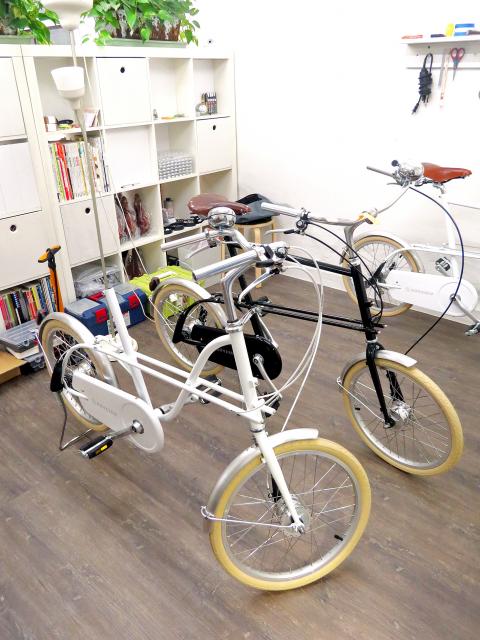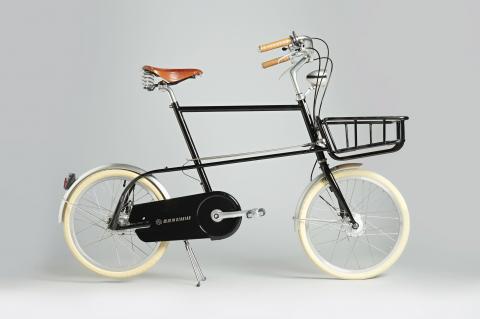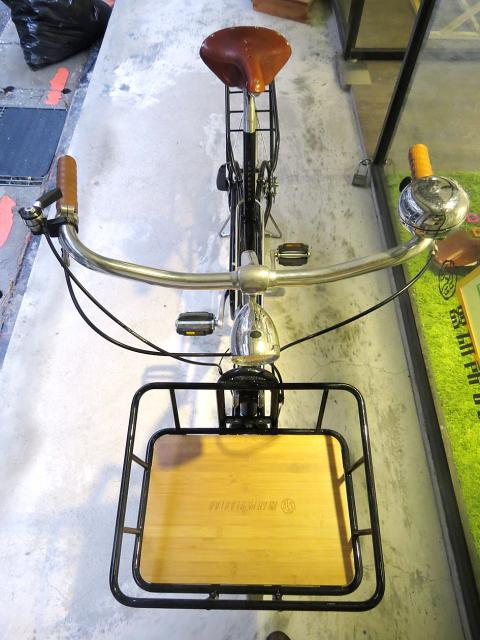In Taiwan’s bicycle manufacturing industry, research and development is concentrated in road bikes, which enjoy a high profit margin. Ninety percent of Giant’s catalog is mountain bikes, road bikes and racing bikes, and last year leaders like Merida vied to release lightweight racers for export to western countries.
However, Henry Chang (張博翔) and Cesare Sun (孫崇實), whose bike design won this year’s Golden Pin Design Award, believe that the future of the industry is not in road bikes.
“A focus in urban cycling will be the next trend of bike development,” says Chang, an industrial designer. “The [road] bike market is already saturated.”

Photo: Enru Lin, Taipei Times
Last year was notably tough for Taiwanese manufacturers. Exports to the US — a main market — fell 8 percent, costing manufacturers an estimated US$43 million in lost sales at wholesale, according to the US Department of Commerce.
In their race to bring road bikes to western markets, Taiwanese industry leaders have ignored the potential of the commuter bike aimed at the urban Asian market, the designers say.
They argue that using a road bike for urban commuting is overkill and a source of dangerous problems. For example, the handlebars of a mountain bike force the cyclist into a forward-leaning position, which partially obstructs the view of traffic.

Photo courtesy of Gearlab
“Holland and Denmark do make bikes that are perfect for riding to work. But because Caucasian and Asian bodies are proportioned differently, those bikes aren’t a good solution for us,” Chang says.
“So there’s a huge market opportunity here, but not many people are looking into it,” Chang says.
TWO MEN AND A BIKE

Photo: Enru Lin, Taipei Times
Chang and Sun stood out as the only two designers in a sea of engineer hires at local computer manufacturer Asustek Computer Inc (華碩). Later, they drew notice as enthusiastic eco-conscious young men who rolled up to the office on bikes.
“Commuting in cities by bike is really a point of pride,” Sun says.
Chang agrees. After three years at Asustek, the two were hired at the same time by Demos Chiang’s (蔣友柏) Dem Inc to design bikes under contract for Giant.
“That’s all we wanted to do — [design] bikes,” Chang says.
“First of all, it was our personal interest. Secondly, bikes are a tremendous challenge, because the appearance is the structure … When you change the appearance of the frame, you change its structure and you get a completely different effect.”
In 2008, Chang and Sun left Dem Inc to start Gearlab, named for its mission to become a star bike-design studio. For the first few years, they designed mostly teapots and mugs, struggling to build capital for developing their dream bike. In between, they conducted market research.
“We considered the different options for a long time. It wasn’t until 2011 that we knew what bike we wanted to go with,” Sun says.
Manufacturers like Giant, Merida and Fritz Jou make mid to high-end bikes for sport use that are purchased by athletes — and by urban consumers who don’t see a better option for commuting. The fold-up bicycle’s popularity in cities peaked around 2009 and, Chang says, is unlikely to return because “an easy-to-ride bike is hard to fold, and an easy-to-fold bike is hard to ride.”
This year, he and Sun put their first bike on the market. The Espresso is a non-foldable bike designed for the East Asian market, and it’s been named a winner of this year’s Golden Pin Design Award.
Unlike a mountain bike, the Espresso permits pedaling in an upright position for a better view of traffic. It also comes with a large kit of accessories tailored for the urbanite: a kickstand, chain guard, LED lights, bike lock, a cargo rack that doesn’t move with the handlebar and a bell with a jaunty two-tone ring so “pedestrians will think you’re funny instead of getting mad when you use it,” Chang says.
THE ROAD AHEAD
Chang and Sun say that for Taiwan’s bicycle manufacturing industry, the commuter bike is a very promising product that needs more development. Giant currently makes some of the best road bikes in the world, but its city-friendly bikes are far less competitive because in-house designers are hired for their background in high-performance engineering.
“Giant finds it hard to extricate itself from the [road] bike mindset. For example, in one lifestyle bike we were designing for them, we suggested adding a chain guard to prevent pant stains … Giant thought it didn’t look sporty or it would add too much weight,” Sun says.
A large company like Giant needs a fundamental shift in approach before it will be able to develop a superb commuter bike. And for a smaller design studio, the task is even tougher, Chang says.
After two years of accepting bicycle design contracts, Dem Inc wanted to move on. That’s because in the design industry, much of the money is elsewhere — for instance in gifts for exhibitions, where contracts are generous and frequent. Designing one bike, in comparison, is time-consuming and rarely cost-effective.
“It’s hard to earn money developing bike concepts,” he says. “As a result, while Taiwan manufactures many bikes, very few people are designing them.”

The Taipei Times last week reported that the rising share of seniors in the population is reshaping the nation’s housing markets. According to data from the Ministry of the Interior, about 850,000 residences were occupied by elderly people in the first quarter, including 655,000 that housed only one resident. H&B Realty chief researcher Jessica Hsu (徐佳馨), quoted in the article, said that there is rising demand for elderly-friendly housing, including units with elevators, barrier-free layouts and proximity to healthcare services. Hsu and others cited in the article highlighted the changing family residential dynamics, as children no longer live with parents,

It is jarring how differently Taiwan’s politics is portrayed in the international press compared to the local Chinese-language press. Viewed from abroad, Taiwan is seen as a geopolitical hotspot, or “The Most Dangerous Place on Earth,” as the Economist once blazoned across their cover. Meanwhile, tasked with facing down those existential threats, Taiwan’s leaders are dying their hair pink. These include former president Tsai Ing-wen (蔡英文), Vice President Hsiao Bi-khim (蕭美琴) and Kaohsiung Mayor Chen Chi-mai (陳其邁), among others. They are demonstrating what big fans they are of South Korean K-pop sensations Blackpink ahead of their concerts this weekend in Kaohsiung.

Taiwan is one of the world’s greatest per-capita consumers of seafood. Whereas the average human is thought to eat around 20kg of seafood per year, each Taiwanese gets through 27kg to 35kg of ocean delicacies annually, depending on which source you find most credible. Given the ubiquity of dishes like oyster omelet (蚵仔煎) and milkfish soup (虱目魚湯), the higher estimate may well be correct. By global standards, let alone local consumption patterns, I’m not much of a seafood fan. It’s not just a matter of taste, although that’s part of it. What I’ve read about the environmental impact of the

Oct 20 to Oct 26 After a day of fighting, the Japanese Army’s Second Division was resting when a curious delegation of two Scotsmen and 19 Taiwanese approached their camp. It was Oct. 20, 1895, and the troops had reached Taiye Village (太爺庄) in today’s Hunei District (湖內), Kaohsiung, just 10km away from their final target of Tainan. Led by Presbyterian missionaries Thomas Barclay and Duncan Ferguson, the group informed the Japanese that resistance leader Liu Yung-fu (劉永福) had fled to China the previous night, leaving his Black Flag Army fighters behind and the city in chaos. On behalf of the